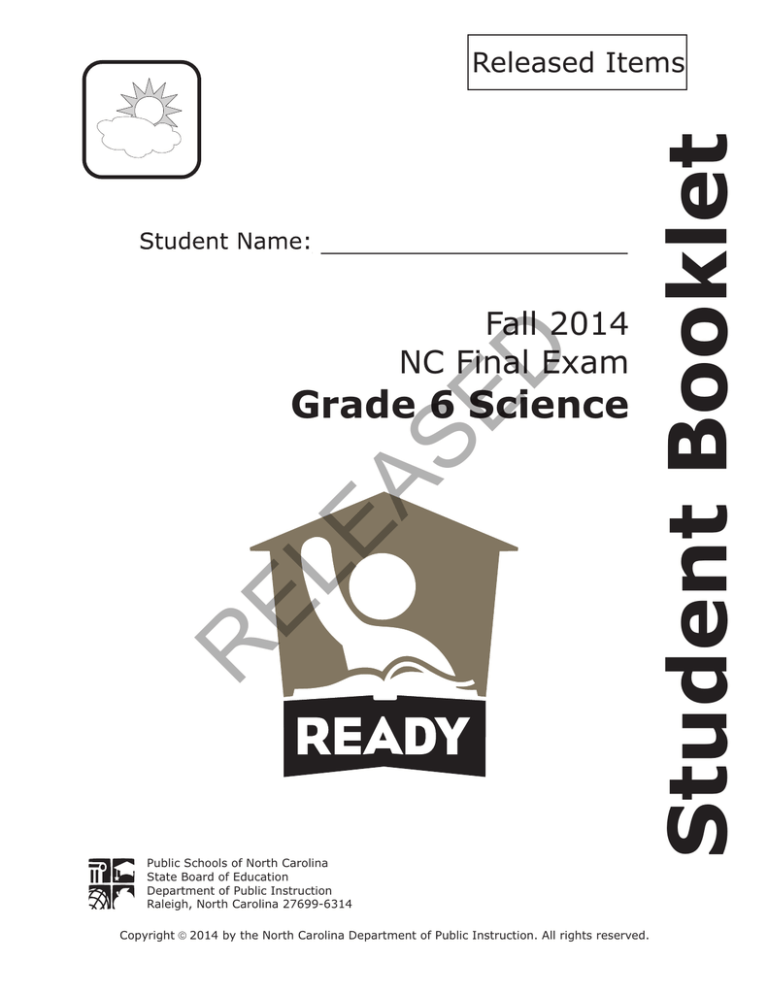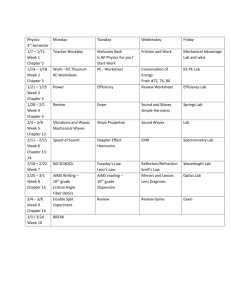
D
Fall 2014
NC Final Exam
R
EL
EA
SE
Grade 6 Science
Public Schools of North Carolina
State Board of Education
Department of Public Instruction
Raleigh, North Carolina 27699-6314
Copyright ã 2014 by the North Carolina Department of Public Instruction. All rights reserved.
Student Booklet
Released Items
GRADE 6 SCIENCE — RELEASED ITEMS
1
This chart gives the physical properties of copper.
Physical Properties of Copper
Element
Density
Melting
Point
Boiling
Point
copper
8.96 g/cm3
1,084°C
2,560°C
How does the density of a 4-g sample of copper compare to that of a 12-g sample
of copper?
3
B
Its density is the same density as the 12-g sample.
C
Its density is twice the density of the 12-g sample.
D
Its density is three times the density of the 12-g sample.
EA
SE
D
Its density is one-half the density of the 12-g sample.
Which is considered a good insulator of heat?
aluminum, because it allows heat to flow easily
B
glass, because it allows heat to flow easily
C
plastic, because heat is unable to flow easily through it
D
silver, because heat is unable to flow easily through it
EL
A
R
2
A
Why are there high and low tides on Earth?
A
They are due to changes in the moon’s tilt on its axis.
B
They are due to the gravitational pull between Earth and the moon.
C
They are due to the magnetic force between Earth and the moon.
D
They are due to changes in the moon’s speed every month.
1
Go to the next page.
GRADE 6 SCIENCE — RELEASED ITEMS
The atmosphere allows all of the sun’s radiation to enter due to Earth’s
distance from the sun.
B
The atmosphere prevents all space debris from reaching the surface due to
the ozone layer.
C
The atmosphere is extremely thin due to the temperatures of the sun.
D
The atmosphere is breathable due to the unique mixture of gases.
How does gravity support life on Earth?
D
A
by forcing Earth to continuously spin on its axis, which contributes to day
and night
B
by causing changes in the distance between Earth and the sun, which
contributes to the seasons
C
by keeping water and gases in the atmosphere close to Earth’s surface,
which contributes to life processes
D
by preventing meteors and comets from hitting Earth’s surface, which
protects living organisms from space fragments
EA
SE
A
EL
5
Which contributes to Earth’s ability to sustain life?
R
4
2
Go to the next page.
GRADE 6 SCIENCE — RELEASED ITEMS
6
The diagram below shows the composition of the surface of Earth.
Composition of the Surface of Earth
land
SE
D
water
Which best summarizes the composition of the surface of Earth?
B
One-fourth of Earth’s surface is water.
C
Earth’s surface contains more land than water.
D
Earth’s surface contains more water than land.
EL
EA
Three-fourths of Earth’s surface is land.
Which is the basic composition of Earth’s core?
R
7
A
A
The solid inner core is surrounded by a liquid outer core.
B
The liquid inner core is surrounded by a solid outer core.
C
Both the inner core and the outer core are solid.
D
Both the inner core and the outer core are liquid.
3
Go to the next page.
GRADE 6 SCIENCE — RELEASED ITEMS
A
They move several miles each year because of convection within Earth.
B
They move several centimeters each year because of convection within
Earth.
C
They move several feet each year because of convection within Earth.
D
They move several kilometers each year because of convection within Earth.
D
This chart compares three different types of waves.
SE
Comparison of P-Waves, Sound Waves, and Light Waves
Occurrence
Wave Characteristics
P-wave
earthquake
compressions and rarefactions
sound
vibrating objects
compressions and rarefactions
light
vibrating charges
crests and troughs
EA
Waves
How do the wave characteristics compare for these waves?
EL
9
Which best explains the movement of tectonic plates?
A
Sound waves and P-waves are longitudinal waves, while light waves are
transverse waves.
B
Light waves and P-waves are transverse waves, while sound waves are
longitudinal waves.
C
Sound waves, P-waves, and light waves are all longitudinal waves.
D
Light waves, P-waves, and sound waves are all transverse waves.
R
8
4
Go to the next page.
GRADE 6 SCIENCE — RELEASED ITEMS
A
Weathered parent rock determines the number of organisms found in the
soil.
B
Weathered parent rock determines the amount of air found in the soil.
C
Weathered parent rock is the largest component of soil.
D
Weathered parent rock is the smallest component of soil.
wall
EA
SE
D
This illustration shows the reaction of a plant when placed near a light source.
EL
11
Which best explains the relationship between parent rock and soil composition?
What would happen to the plant if it were turned away from the light source?
R
10
A
The plant would stop growing.
B
The plant would be unaffected.
C
The plant would move away from the light source.
D
The plant would bend towards the light source.
5
Go to the next page.
GRADE 6 SCIENCE — RELEASED ITEMS
14
A
by limiting pruning and trimming of the tulips
B
by reducing water levels and nutrient uptake by the tulips
C
by elevating oxygen levels and supplying organic matter to the tulips
D
by increasing temperature and lengthening daylight for the tulips
D
How does sound usually travel?
An object vibrates, and those vibrations travel through the air in one
direction as transverse waves.
B
An object vibrates, and those vibrations carry air in one direction as
longitudinal waves.
C
An object vibrates, and those vibrations carry air in all directions as
transverse waves.
D
An object vibrates, and those vibrations travel through the air in all
directions as longitudinal waves.
EA
SE
A
EL
13
Tulips are flowers that typically bloom in the spring. How could tulips be forced to
bloom in winter?
Which is true for every atom of an element?
R
12
A
It can be seen with a magnifying glass.
B
It is joined together with another atom.
C
It has mass and volume.
D
It is weightless.
6
Go to the next page.
GRADE 6 SCIENCE — RELEASED ITEMS
A student has two pieces of aluminum foil. Each piece can be folded and rolled into
a wire. Why do both pieces of aluminum foil behave the same way?
They are composed of the same types of atoms.
B
They are composed of different types of atoms.
C
They have the same physical properties, but different chemical properties.
D
They have the same chemical properties, but different physical properties.
EL
EA
SE
D
A
R
15
7
Go to the next page.
GRADE 6 SCIENCE — RELEASED ITEMS
This is the end of the Grade 6 Science Released Items.
Directions:
1. Look back over your answers for the test questions.
2. Make sure all your answers are entered on the answer sheet. Only what is
entered on your answer sheet will be scored.
3. Put all of your papers inside your test book and close the test book.
SE
D
4. Stay quietly in your seat until your teacher tells you that testing is
finished.
R
EL
EA
5. Remember, teachers are not allowed to discuss items from the test with
you, and you are not allowed to discuss with others any of the test
questions or information contained within the test.
8
GRADE 6 SCIENCE — RELEASED ITEMS
Type2
Key
Percent Correct3
Standard
1
MC
B
25%
6.P.2.3
2
MC
C
41%
6.P.3.3
3
MC
B
69%
6.E.1.1
4
MC
D
59%
6.E.1.2
5
MC
C
56%
6.E.1.2
6
MC
D
91%
6.E.2.1
7
MC
A
44%
6.E.2.1
8
MC
B
57%
6.E.2.2
MC
A
55%
6.P.1.1
MC
C
41%
6.E.2.3
MC
D
62%
6.L.2.2
MC
D
66%
6.L.2.2
13
MC
D
45%
6.P.1.3
14
MC
C
49%
6.P.2.1
15
MC
A
71%
6.P.2.1
11
12
EA
EL
10
R
9
SE
Item Number
D
Grade 6 Science
RELEASED Items1
Fall 2014
Answer Key
1
GRADE 6 SCIENCE — RELEASED ITEMS
1
These released items were administered to students during a previous test administration. This
sample set of released items may not reflect the breadth of the standards assessed and/or the
range of item difficulty found on the NC Final Exam. Additional items may be reviewed at
http://www.ncpublicschools.org/accountability/common-exams/released-forms/. Additional
information about the NC Final Exam is available in the Assessment Specification for each exam
located at http://www.ncpublicschools.org/accountability/common-exams/specifications/.
2
This NC Final Exam contains only multiple-choice (MC) items.
3
R
EL
EA
SE
D
Percent correct is the percentage of students who answered the item correctly during the
Spring 2014 administration.
2
GRADE 6 SCIENCE — RELEASED ITEMS
Standard Descriptions
Only clarifying objective descriptions addressed by the released items in this booklet are listed
below. A complete list of the North Carolina Essential Standards for Science and Social studies
may be reviewed at http://www.ncpublicschools.org/acre/standards/new-standards/.
6.P.1.1 (Forces and Motion)
Compare the properties of waves to the wavelike property of energy in earthquakes, light and
sound.
D
6.P.1.3 (Forces and Motion)
Explain the relationship among the rate of vibration, the medium through which vibrations
travel, sound and hearing.
SE
6.P.2.1 (Properties and Change)
Recognize that all matter is made up of atoms and atoms of the same element are all alike, but
are different from the atoms of other elements.
EA
6.P.2.3 (Properties and Change)
Compare the physical properties of pure substances that are independent of the amount of
matter present including density, melting point, boiling point, and solubility to properties that
are dependent on the amount of matter present to include volume, mass and weight.
6.P.3.3 (Conservation and Transfer)
Explain the suitability of materials for use in technological design based on a response to heat
(to include conduction, expansion, and contraction) and electrical energy (conductors and
insulators).
EL
6.E.1.1 (Earth in the Universe)
Explain how the relative motion and relative position of the sun, Earth and moon affect the
seasons, tides, phases of the moon, and eclipses.
R
6.E.1.2 (Earth in the Universe)
Explain why Earth sustains life while other planets do not based on their properties (including
types of surface, atmosphere and gravitational force) and location to the Sun.
6.E.2.1 (Earth Systems, Structures and Processes)
Summarize the structure of the earth, including the layers, the mantle and core based on the
relative position, composition and density.
6.E.2.2 (Earth Systems, Structures and Processes)
Explain how crustal plates and ocean basins are formed, move and interact using earthquakes,
heat flow and volcanoes to reflect forces within the earth.
6.E.2.3 (Earth Systems, Structures and Processes)
Explain how the formation of soil is related to the parent rock type and the environment in which
it develops.
6.L.2.2 (Ecosystems)
Explain how plants respond to external stimuli (including dormancy and forms of tropism) to
enhance survival in an environment.
3




